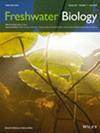eDNA如何准确反映冷水鱼类的空间分布?温带湖泊的现场验证
IF 2.7
2区 生物学
Q2 ECOLOGY
引用次数: 0
摘要
基于环境DNA (eDNA)的检测技术在水生生物分布评价中的应用日益增多;然而,eDNA的现场验证对于测量研究系统的准确性非常重要。为了成功地将该技术应用于物种保护,了解物种生物学和环境条件如何影响eDNA检测数据推断的准确性至关重要。我们对重新引入深温带湖泊的原生冷水鱼群cisco Coregonus artedi进行了基于edna的物种分布精度和空间分辨率的实地评估。我们结合了声学遥测技术,提供了已知的标记鱼的空间位置,以及整个湖泊的eDNA采样来推断它们在美国纽约库卡湖的分布。收集了地下(12米和18米深度)的eDNA样本,以适应该鱼类的垂直迁移行为。本研究的结果验证了标记鱼在粗空间尺度上的阳性eDNA检测的准确性。然而,几个精细尺度的位置揭示了eDNA和声学遥测检测之间的不匹配;与遗传物质通过湖流的快速运输相一致。利用漂流者对湖流进行的经验测量发现,在24小时的运输周期内,思科eDNA检测结果可能会偏离样本源位置,在12米深度时可能偏离3.3公里,在18米深度时可能偏离1.5公里。我们的研究表明,从湖泊eDNA采样中估计出的准确物种分布可能需要进一步了解环境遗传物质的运输机制和持久性,以便将点检测与源动物位置联系起来。将eDNA采样与物种生物学和环境条件的额外数据收集相结合,将提高鱼类分布评估的空间分辨率。本文章由计算机程序翻译,如有差异,请以英文原文为准。
How Accurately Does eDNA Reflect the Spatial Distribution of Cold-Water Fish? Field Validation From a Temperate Lake
- Applications of environmental DNA (eDNA) based detection technology to evaluate the distribution of aquatic organisms are increasing; yet field validations of eDNA are important to measure accuracy in study systems. To successfully apply this technology to species conservation, it is critical to understand how both species biology and environmental conditions affect the accuracy of inference from eDNA detection data.
- We implemented a field assessment of the accuracy and spatial resolution of eDNA-based species distributions for a native cold-water, schooling fish, cisco Coregonus artedi, that has been reintroduced to a deep temperate lake. We leveraged a combination of acoustic telemetry, providing known spatial locations of tagged fish, and lake-wide eDNA sampling to infer their distribution in Keuka Lake, New York, USA. Sub-surface (12 m and 18 m depths) eDNA samples were collected to accommodate the diel vertical migration behaviour of this fish species.
- The results of this study validated the accuracy of positive eDNA detections with the distribution of tagged fish to coarse spatial scales. Yet, several fine-scale locations revealed a mismatch between eDNA and acoustic telemetry detections; consistent with rapid transport of genetic material via lake currents.
- Empirical measurements of lake currents using drifters found cisco eDNA detections could deviate from specimens' source locations by as much as 3.3 km at 12 m depth or 1.5 km at 18 m depth over a 24 h transport period.
- Our study indicates that accurate species distributions estimated from eDNA sampling in lakes may require further understanding of transport mechanisms and persistence of environmental genetic material to relate point detections to source animal locations. Integrating eDNA sampling with additional data collection of species biology and environmental conditions will increase the spatial resolution of fish distribution assessments.
求助全文
通过发布文献求助,成功后即可免费获取论文全文。
去求助
来源期刊

Freshwater Biology
生物-海洋与淡水生物学
CiteScore
5.90
自引率
3.70%
发文量
162
审稿时长
2 months
期刊介绍:
Freshwater Biology publishes papers on all aspects of the ecology of inland waters, including rivers and lakes, ground waters, flood plains and other freshwater wetlands. We include studies of micro-organisms, algae, macrophytes, invertebrates, fish and other vertebrates, as well as those concerning whole systems and related physical and chemical aspects of the environment, provided that they have clear biological relevance.
Studies may focus at any level in the ecological hierarchy from physiological ecology and animal behaviour, through population dynamics and evolutionary genetics, to community interactions, biogeography and ecosystem functioning. They may also be at any scale: from microhabitat to landscape, and continental to global. Preference is given to research, whether meta-analytical, experimental, theoretical or descriptive, highlighting causal (ecological) mechanisms from which clearly stated hypotheses are derived. Manuscripts with an experimental or conceptual flavour are particularly welcome, as are those or which integrate laboratory and field work, and studies from less well researched areas of the world. Priority is given to submissions that are likely to interest a wide range of readers.
We encourage submission of papers well grounded in ecological theory that deal with issues related to the conservation and management of inland waters. Papers interpreting fundamental research in a way that makes clear its applied, strategic or socio-economic relevance are also welcome.
Review articles (FRESHWATER BIOLOGY REVIEWS) and discussion papers (OPINION) are also invited: these enable authors to publish high-quality material outside the constraints of standard research papers.
 求助内容:
求助内容: 应助结果提醒方式:
应助结果提醒方式:


